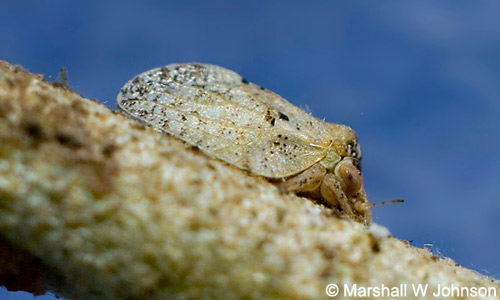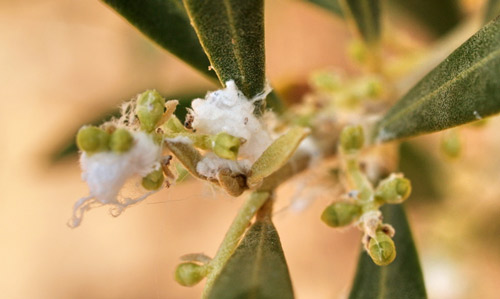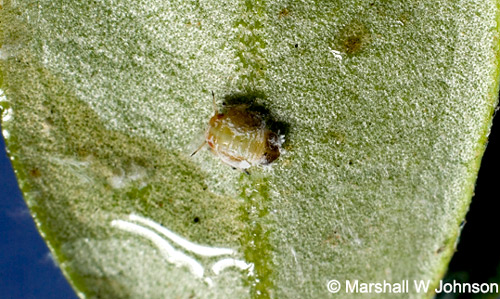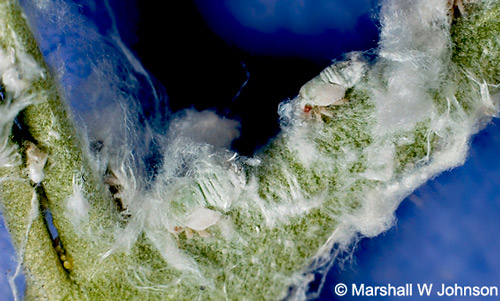common name: olive psyllid (suggested common name)
scientific name: Euphyllura olivina (Costa 1839) (Hemiptera: Psyllidae)
Introduction - Distribution - Description - Life Cycle and Biology - Hosts - Management - Selected References
Introduction (Back to Top)
The olive psyllid, Euphyllura olivina (Costa), belongs to the superfamily Psylloidea, which consists of six families. As its common name suggests, the olive psyllid (Figure 1) is found within the family Psyllidae, which contains over 100 genera (Myers et al. 2016). Psyllids are often referred to as jumping plantlice due to their quick jumping movements. Psyllids generally are monophagous (feeding on one plant species) or oligophagous (feeding on plants within a single family) (Kabashima et al. 2014). However, the olive psyllid is polyphagous, but it only feeds on a few different plants (see hosts section below). Currently, the olive psyllid is not found in Florida, but it does have the potential to spread to new locations via olive tree importation.
The olive psyllid nymphs and adults produce a white, waxy secretion (Figure 2), which can cause premature flower drop during infestations. The waxy secretion completely covers the nymphs, most likely to hide them from predators or to prevent desiccation (M.W. Johnson, personal communication). Honeydew, also produced by nymphs and adults, can lead to sooty mold development on the surface of the host plant (Johnson 2009).
Figure 1. Adult olive psyllid, Euphyllura olivina (Costa). Photograph by Marshall W. Johnson, Center for Invasive Species Research, University of California Riverside.
Figure 2. Secretions made by Euphyllura olivina (Costa) on buds of an olive tree, Olea europaea L. Photograph courtesy of Wikimedia Commons (User Morini33, CC BY 3.0).
Distribution (Back to Top)
According to the Psylloidea database Psyl’list, the olive psyllid has been recorded in most olive growing regions of the world including: Algeria, Austria, England, France, Germany, India, Iran, Italy, Montenegro, Morocco, Portugal, Slovenia, Spain, Switzerland, Tunisia, and the United States (Ouvrard 2016, Meftah 2014). It was first discovered in California in July 2007 in San Diego and Orange counties (Johnson et al. 2010).
Description (Back to Top)
The olive psyllid life cycle lasts about three months depending on the temperature, with optimal conditions being between 20 and 25°C (68 and 77°F) (Johnson et al. 2010). The rate of mortality increases at temperatures above 32.2°C (90°F). In California, psyllid populations decline after June due to the rise in temperature and populations do not recover until the following spring (Zalom et al. 2014).
Typically, three generations of olive psyllids occur annually. The first generation feeds as nymphs beginning in March (Alford 2014). The second generation begins feeding in May but becomes inactive (going through aestivation) once temperatures reach 27.2°C (81°F) (Alford 2014, Johnson 2009). The aestivating olive psyllids hide in cracks of the trunk of the host plant (Zalom et al. 2014). When temperatures become optimal again, usually in September, the olive psyllid nymphs return to an active state (Alford 2014). The third generation of nymphs appears in September and October (Zalom et al. 2014).
Most native psyllids in California are not pests on olives, but introduced species, like the olive psyllid, typically become pests (Kabashima et al. 2014). When nymphs and adults feed, they rupture plant cells and suck sap from the host plant, reducing levels of nutrients reaching certain parts of the host. This only becomes a problem when olive psyllids are on inflorescences (flower clusters), which ultimately affects fruit production. Outside of the United States, more than 20 nymphs per inflorescence have caused yield losses of up to 60% (Johnson 2009). Additionally the accumulation of waxy secretions from olive psyllids may reduce yield by causing premature flower drop (Johnson et al. 2010).
Both immature and adult olive psyllids excrete honeydew due to their inability to utilize all of the sugar and water in the plant sap ingested during feeding. The accumulation of honeydew on foliage provides a substrate for development of sooty mold (Figure 3), which can potentially block sunlight and inhibit photosynthesis, or lead to premature aging of leaves that causes the leaves to drop (Laemmlen 2014). The second generation causes the most economic damage to olive because the immature olive psyllids are present during fruit production (M.W. Johnson, personal communication).
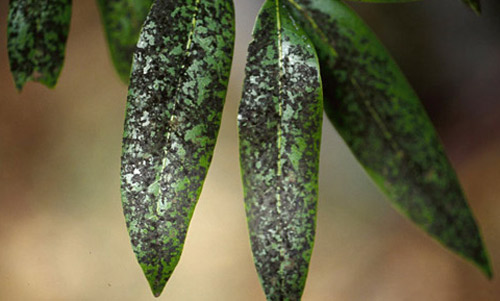
Figure 3. Sooty mold on leaves of California laurel, Umbellularia californica. Photograph by Joseph O'Brien, USDA Forest Service, Bugwood.org (CC BY 3.0 US).
Life Cycle and Biology (Back to Top)
Eggs: Female olive psyllids lay eggs on new shoots, leaves, and buds (Johnson 2009, Zalom et al. 2014). Females can lay up to 1,000 eggs during their lifespan (Johnson 2009). The eggs, which take one to two weeks to hatch (Alford 2014), are oval in shape, light yellow, and about 0.3 mm long (Zalom et al. 2014).
Nymphs: Nymphs (Figures 4 and 5) have a flattened, light green and white body and reddish-purple eyes. The olive psyllid goes through five nymphal stages (that range from 0.4 mm to 1.5 mm long), which last a total of about five weeks until the adult stage is reached (Zalom et al. 2014, Alford 2014).
Figure 4. An olive psyllid, Euphyllura olivina (Costa), in its first instar on an olive leaf. Photograph by Marshall W. Johnson, Center for Invasive Species Research, University of California Riverside.
Figure 5. Olive psyllid, Euphyllura olivina (Costa), nymphs on olive stem. Notice the waxy secretions covering the stem. Photograph by Marshall W. Johnson, Center for Invasive Species Research, University of California Riverside.
Adults: Adult olive psyllids are dull green to gray in color with slightly black-mottled forewings. The adults are about 2.0 to 2.5 mm long (Alford 2014). Adult males live between 24 and 44 days and females live between 26 and 50 days (Meftah et al. 2014).
Hosts (Back to Top)
The olive psyllid feeds on Russian olive (Elaeagnus angustifolia L.), green olive (Phillyrea latifolia L.), and olive (Olea europaea L.) (Johnson 2009). In a study comparing Haouzia, Arbequina, Manzanilla, and Picholine Marocaine varieties and published in the Official Journal of the International Olive Council, scientists discovered olive psyllids performed differently on different olive tree varieties. The success rate for olive psyllid development was highest for the Haouzia variety (Meftah et al. 2014). Additionally, olive psyllids tend to select healthy hosts over unhealthy hosts (M.W. Johnson, personal communication). An unhealthy host may be suffering from infestation by other pests or disease or may be in a location unsuitable for ideal growth.
Management (Back to Top)
Host plants need to be monitored for olive psyllid populations to prevent infestations from establishing in new locations. Methods of monitoring include using sticky traps, agitating foliage to count fallen adults, and careful inspection of plant parts for eggs, nymphs, and adults (Kabashima et al. 2014). Plant suckers (shoots) at the base of the tree, if they have not been removed, should be inspected for olive psyllids (M.W. Johnson, personal communication). It is best to monitor for the first generation of olive psyllids because the reduction of that generation can substantially reduce population levels of the second generation. Treatment is advised if more than ten olive psyllids are found per inflorescence (Zalom et al. 2014). In the United States, olive psyllid infestations are mostly found on ornamental olive trees (Johnson 2009).
Cultural control: Olive psyllid populations may be reduced by pruning. Growers can prune infested areas, mainly suckers, along with center limbs to enhance air circulation that increases heat exposure to olive psyllids (Johnson 2009, Kabashima et al. 2014).
Chemical control: Insecticides, should they become necessary, are best used before olive psyllids begin producing their waxy secretions, which can provide protection from chemicals (Zalom et al. 2014). Because the secretions complicate control strategies, insecticides should target the first generation to avoid problematic second generation infestations (Kabashima et al. 2014). There are nonresidual, contact insecticides that work against psyllids, such as neem oil, insecticidal soap, and horticultural oil (Kabashima et al. 2014).
Biological control: Tunisian scientists reported that the olive psyllid is parasitized by the endoparasitic wasp Psyllaephagus euphyllurae (Masi), and its predators include a minute pirate bug, Anthocoris nemoralis (L.), a lacewing, Chrysoperla carnea (Stephens), and a lady beetle, Coccinella septempunctata L. Anthocoris nemoralis was the most abundant predator accounting for49% of the total natural enemies found (Gharbi et al. 2012). In the United States, a lady beetle called the mealybug destroyer (Cryptolaemus montrouzieri), green lacewing (Chrysoperla rufilabris) larvae, and some other species of lady beetles have occasionally been found around the olive psyllid (Johnson et al. 2010). Researchers in California plan to evaluate whether the mealybug destroyer and the green lacewing will be able to control infestations (Johnson 2009).
Selected References (Back to Top)
- Alford DV. 2014. Pests of fruit crops: A colour handbook, second edition. CRC Press, London, UK.
- Gharbi N, Dibo A, Ksantini M. 2012. Observation of arthropod populations during outbreak of olive psyllid Euphyllura olivina in Tunisian olive groves. Tunisian Journal of Plant Protection 7: 27-34.
- Johnson MW, Daane KM, Lynn-Patterson K. 2010. Appraising the threat of olive psyllid to California table olives. pp. 1-11. Final report 2010, California Olive Committee.
- Johnson MW. (2009). Olive psyllid, Euphyllura olivina (Costa) (Hemiptera: Psyllidae). Center for Invasive Species Research. University of California Riverside. (1 April 2016)
- Kabashima JN, Paine TD, Daane KM, Dreistadt SH. (2014). Psyllids: Integrated pest management for home gardeners and landscape professionals. University of California, Agriculture and Natural Resources. Pest Notes Publication 7423. (31 March 2016)
- Laemmlen FF. (2014). Pests in gardens and landscapes: Sooty mold. Statewide Integrated Pest Management Program, University of California Agriculture and Natural Resources. (6 April 2016)
- Meftah H, Boughdad A, Bouchelta A. 2014. Comparison of biological and demographic parameters of Euphyllura olivina Costa (Homoptera, Psyllidae) on four varieties of olive. Official Journal of the International Olive Council 120: 3-17.
- Myers P, Espinosa R, Parr CS, Jones T, Hammond GS, Dewey TA. (2016). Psyllidae. Animal Diversity Web. University of Michigan Museum of Zoology. (31 March 2016)
- Ouvrard D. (2016). Species: Euphyllura olivina (Costa, 1839). Psyl’list: The World Psylloidea Database. (1 April 2016)
- Zalom FG, Vossen PM, van Steenwyk RA, Johnson MW. (2014). UC pest management guidelines: Olive psyllid. Statewide Integrated Pest Management Program, University of California Agriculture and Natural Resources. (31 March 2016)
